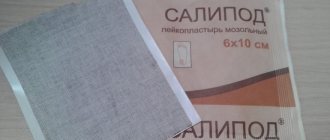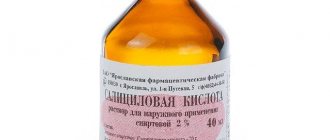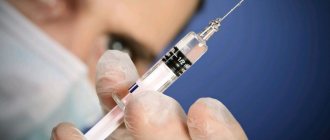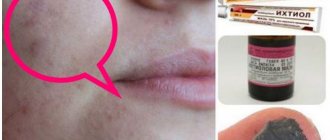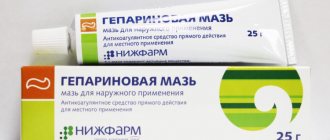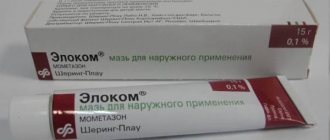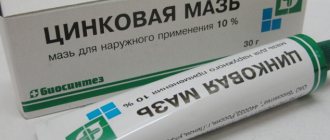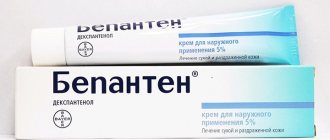Skin rashes, acne, acne, pimples can appear for various reasons, one of the common ones is disruption of the sebaceous glands. In these cases, many dermatologists recommend using a product such as Synthomycin ointment.
The use of this remedy allows you to eliminate the dysfunction of sebum production, which often causes the appearance of pimples, blackheads and other unpleasant skin lesions. But still, first you should carefully study all the properties of this drug.
Description, composition
Syntomycin is an antibacterial agent that is intended for external use. In appearance, the ointment is a substance with a white structure that has a slight characteristic odor.
When using this remedy, you can easily eliminate acne, lesions with a purulent structure, ulcers, burns, purulent wounds, boils and carbuncles. After treatment with these products, the skin becomes fresh, healthy, and many dermatological problems are eliminated.
The main component of this product includes chloramphenicol or chloramphenicol. This element is an antibiotic with a wide range of effects. It is due to this element that the drug has a direct effect on almost all types of bacteria. It stops their growth, development, and also prevents their further reproduction.
Note! This product is available only in the form of an ointment for external use. The drug is not taken orally because it can cause a large number of side symptoms.
In addition to the main component, the composition also contains additional elements:
- Castor oil;
- sorbic acid;
- ethylcellulose;
- purified water;
- emulsifier.
Due to the fact that the ointment contains castor oil, it enhances the action of the antibiotic, effectively relieves the inflammatory process, and has a pronounced antiseptic effect.
Compound
Synthomycin ointment is an emulsion of syntomycin . The drug is available in three different concentrations of the active substance: 1%, 5% and 10%. The auxiliary components are as follows:
- Castor oil,
- emulsifier,
- preservative,
- distilled water.
The color of the ointment may be white or slightly yellowish. The drug has a specific and subtle odor .
The main component of the ointment, syntomycin, is a broad-spectrum antibiotic. It destroys bacteria resistant to penicillin and its derivatives.
Also, syntomycin does not allow pathogens to spread under the skin. This provides effective acne treatment.
Castor oil fights inflammatory processes and has an additional antiseptic effect. It prevents dry skin, doesn't clog pores, and lightens the spots left behind by treated acne.
The remaining ingredients are added to the ointment to maintain consistency and maintain the effectiveness of the drug throughout the shelf life (2 years).
Benefits of use
Syntomycin acne ointment is a popular remedy that is used to improve the condition of problem skin. The increased demand for this drug is explained by the presence of a number of advantages:
- first of all, this product has a fairly low price, in contrast to products that are intended to treat skin lesions;
- has a direct effect on the main cause of the lesion and completely destroys pathogenic bacteria;
- has extensive access. This drug can be purchased at any pharmacy without a doctor's prescription;
- quick effect. A positive result will be visible within two days after the start of use;
- Due to the fact that it contains castor oil, it does not dry out the skin.
Effect of syntomycin ointment
This complex remedy consists of an antibiotic - Levomycetin and castor oil. The first component is able to fight many types of bacteria that disrupt the microflora in certain areas of the skin. In most cases, it is not addictive, therefore it is able to eliminate the resulting rashes without consequences.
Both ingredients of the medicinal ointment have the ability to penetrate deeply into the skin and destroy the membranes of pathogens, leading to their death. This is done while protecting healthy areas of the skin. The ointment affects bacteria and prevents their proliferation and eliminates them quickly and locally, as a result they are not able to spread further across the face.
Castor oil has an antiseptic and anti-inflammatory effect on the skin, due to which pimples and the area around them are well disinfected and dried, which leads to the rapid elimination of inflammatory processes on the face. It is this oil component that protects the skin from drying out when using the ointment, thanks to it the pores do not become clogged and the product acts gently on the skin, affecting only inflammation. In addition, after using it, there will be no pigment spots on the face, which are usually present after acne goes away.
But it is impossible to say that the ointment is capable of eliminating outdated acne. It is still designed to eliminate acne that has arisen as a result of bacterial damage. Syntomycin antibacterial ointment is able to fight various types of pimples, acne and even boils, promoting their rapid opening. She successfully fights any manifestations of infections. As for post-acne, here you can read how to get rid of stagnant spots against acne.
Read how to avoid irritation after shaving in the bikini area.
Reviews of ointments for acne scars on the face: .
Find out how to treat a cold pimple on the nose.
How to apply
How should I use Syntomycin for acne? It is imperative to use this product correctly, this is what determines the positive result and complete elimination of all skin lesions. For this reason, you need to carefully study all the recommendations specified in the instructions. It is also worth getting examined and consulting with a doctor.
When using Synthomycin ointment, the following rules must be observed:
- First you need to prepare the skin, it should be washed with water, cleaned and dried;
- When cleansing the skin, it is not recommended to use cosmetics;
- After the skin has dried, it is necessary to apply the ointment to areas with rashes and inflammation using a cotton swab;
- It is recommended to perform the treatment twice a day for 5-7 days.
Interactions and incompatibility with drugs
The drug is not recommended for use with other drugs; if it is necessary to use complex therapy, you must first consult with your doctor.
Syntomycin is a white emulsion that is odorless. It is able to quickly absorb into fabrics and does not leave greasy marks or stain clothes. You can purchase the product without a prescription, and its cost is around 50 rubles. Synthomycin liniment is packaged in aluminum tubes of 10 g or 25 g. The concentration of the drug can be 1%, 5% or 10%.
The composition of synthomycin ointment contains the following components:
- antibiotic synthomycin (chloramphenicol) is the main active ingredient. It has a wide spectrum of action and is active against most pathogenic bacteria that cause inflammation and suppuration. Under the influence of an antibiotic, protein synthesis in bacteria is disrupted, causing them to lose their ability to reproduce. The peculiarity of the substance is that pathogenic bacteria are not able to get used to it, and therefore the use of the ointment does not threaten the development of persistent microorganisms;
- castor oil - this component enhances the penetration of the antibiotic into tissues, and also has pronounced antibacterial, moisturizing and anti-inflammatory properties. The therapeutic effect of the antibiotic when combined with castor oil is significantly enhanced.
Syntomycin liniment also contains auxiliary components, such as preservatives and emulsifiers. Their presence should be taken into account, since they can also cause allergic reactions to the drug.
special instructions
When using Synthomycin ointment, it is recommended to follow the following important instructions:
- The product is recommended to be applied to previously cleansed skin;
- You should not combine ointment with other medications and cosmetics, this can cause serious harm to health and cause complications;
- The course of treatment should be 7-10 days, and it should not be exceeded without doctor’s recommendations;
- The ointment is used only for the treatment of skin diseases; this remedy is not suitable for prevention;
- Do not apply to skin with damage, wounds, or scratches.
Price
The drug can be purchased from 20 to 90 rubles. This range is influenced by the manufacturer and location of the pharmacy.
Syntomycin ointment is often used against acne, but it is also effective for pustular inflammation, carbuncles, boils, burns and cracked nipples during lactation. Its affordable price allows you to use the product on fairly large affected areas of the skin. It is practically non-addictive. Microbes develop resistance to it slowly. Therefore, you can treat acne as it appears, taking short breaks between courses. To treat acne, masks against pimples and blackheads and anti-acne lotions in the pharmacy are also used. For teenagers, you can use a cream for teenage acne on the face.
Contraindications
When using, you should pay attention to contraindications, and there are quite a few of them:
- not used for eczema, psoriasis, various dermatological diseases;
- should not be applied if there are fungal infections;
- in the presence of large open wounds, as well as with a purulent structure;
- problems with hematopoiesis;
- severe kidney and liver diseases;
- in the presence of neoplasms on the skin that are benign or malignant;
- if there is hypersensitivity to the constituent components;
- period of bearing a child;
- lactation.
Important! When using Syntomycin ointment, unpleasant symptoms may appear - redness, itching, burning, swelling, allergic rashes. In these cases, you should stop using this remedy and consult a doctor.
If you follow the instructions correctly, unpleasant symptoms can be completely avoided. In addition, do not forget about contraindications, because if you use the product in the presence of these indications, serious health problems may arise. For this reason, it is worth first being examined by a doctor.
Contraindications and restrictions
The main negative consequence after therapy is an allergic reaction, Quincke's edema. An unfavorable outcome of the therapeutic effect occurs due to individual intolerance to the active and additive components.
The main contraindications include:
- pregnancy and lactation period,
- chronic diseases of the liver, kidneys,
- purulent open wounds,
- children's age up to 1 month,
- psoriasis, eczema and other skin diseases,
- fungal infections of the epidermis,
- oncological formations on the skin,
- damage by cancer cells to other organs,
- hematopoietic disorder.
Syntomycin ointment: instructions for use for acne
The use of synthomycin ointment in medicine is widespread. The therapeutic effect of the antibacterial agent allows you to fight problems caused by streptococci, salmonella, staphylococci, shigella, meningococci, gonococci and E. coli.
The use of ointment is prescribed in the following cases:
- ulcers, including trophic ones;
- carbuncles;
- boils;
- acne and skin inflammation for their reasons;
- purulent wounds;
- vulvitis;
- hemorrhoids – for hemorrhoids, syntomycin ointment is prescribed if the nodes are localized externally. For internal nodes, suppositories with this antibiotic are prescribed. The possibility of using syntomycin for therapy is determined by the attending physician, since the use of the drug is not permitted in every case;
- purulent-inflammatory skin diseases;
- trachoma;
- during lactation, in cases of cracked nipples;
- second and third degree burns - for burns, synthomycin ointment is used after opening the bladder and cleansing the wound of purulent-necrotic masses, the removal of which is carried out not with the help of liniment, but with the use of levomikol ointment;
- demodicosis;
- hidradenitis - purulent inflammation of the sweat gland;
- impetigo;
- shingles;
- cracks on the lips;
- sycosis – purulent inflammation of the hair follicle;
- diaper rash;
- water calluses if the skin is torn.
Syntomycin ointment should not be put into the nose. The drug is mistakenly used for a runny nose, introducing turundas into the nose, which only worsens the condition. The composition is not used for respiratory diseases. Syntomycin is intended only for external use and application to the mucous membranes of the external genitalia, but not the mouth or nose.
Syntomycin ointment should be used strictly following the instructions. If the dose of the drug is significantly exceeded, it negatively affects the patient's condition due to toxic effects.
To treat purulent cavities and fistula tracts, their preliminary surgical treatment is necessary. Without it, you cannot start using liniment, since it will not be able to penetrate into the deep layers of tissue and have the necessary effect. After cleaning the cavities, they are loosely filled with tampons soaked in the drug.
Liniment eliminates acne with high efficiency. It is recommended to use it if other compounds are not used. Depending on how intense the rash occurs, the drug is applied in different ways.
For severely inflamed acne, use an ointment with a concentration of 10%. It is applied only pointwise to the sore spot. Each pimple must be treated morning and evening. This treatment lasts until acne is completely eliminated, which takes an average of 5 days.
If acne is abundant, but there is no severe inflammation, then it is recommended to use 1% liniment as a cream. Apply a thin layer to the face morning and evening, avoiding the area around the eyes. If the composition is not completely absorbed, then warm boiled water is used to remove its residues from the skin, but not earlier than an hour after application.
As a mask, synthomycin liniment 5% is applied to the skin in a thick layer if there are multiple inflamed nodes. This treatment is carried out once a day. With more frequent use, there is a high risk of overdose, which requires separate treatment. Keep the mask for half an hour, after which it is washed off with boiled warm water.
For burns
For burns, synthomycin 10% is used. Therapy against damage needs to be comprehensive and the use of liniment alone is insufficient. Synthomycin ointment for burns is effective only if the germ layer of the skin is not affected. If it is destroyed, this therapy is not carried out. For 2nd and 3rd degree burns, liniment allows you to avoid the development of bacterial infection, purulent complications and the formation of significant scars.
To treat a burn, a sterile gauze bandage is soaked in syntomycin and applied to the affected area. The bandage should be changed once a day. If pain and itching occur under the gauze during the day, the bandage can be replaced with a new one, but only if the area treated with ointment is small. For large areas of the burn, repeated application of the ointment on the same day is prohibited. Treatment is carried out until the damaged area is completely healed.
In ophthalmology
The ointment is also effective for the eyes, for diseases such as various inflammations of the eyelids. In these cases, syntomycin liniment is used only strictly according to medical indications. The product can be applied with a concentration of 1% or 5%, which is determined by the ophthalmologist. It is unacceptable to prescribe a drug without permission.
The ointment is applied pointwise to the area of inflammation and in such a way that it does not get on the mucous membrane of the eye. If this happens, you must immediately rinse your eye with cold running water. The eyelids should be treated with ointment 2 times a day for 7-10 days. If the inflammation subsides earlier, early cessation of therapy is permitted.
For herpes on the lips
Syntomycin ointment is a unique antibiotic drug, as it can treat not only bacterial infections, but also inhibit the herpes virus. Other antibiotics are completely useless against herpes. As soon as a problem is detected, synthomycin ointment is applied to the area of the rash on the lips 4 times a day until the tissues are completely healed. It is not prohibited to combine the drug with other agents whose action is aimed at eliminating this infection.
In cosmetology
Liniment is also used in the fight against age spots. For these purposes, you should purchase the composition in a concentration of 10%.
It is applied 3 times a day in a thick layer to the affected areas of the skin, without covering the normal ones. In a similar way, ointment is applied to get rid of scars left after purulent acne on the face. The course of such therapy takes from 10 to 14 days. The liniment should be washed off after 3 hours with warm water. It must be borne in mind that the ointment is medicinal and cannot be used continuously as a cosmetic product.
For hemorrhoids
For hemorrhoids, treatment with syntomycin should be agreed with a doctor. If the cones are external, then after washing them, they are treated with ointment in the morning and evening until the unpleasant symptoms of the disease are relieved. For internal lumps, a gauze swab is soaked in the drug, which is inserted at night before bed after cleansing the intestines. This tampon will come out on its own in the morning at the time of bowel movement.
Diaper rash
Liniment is applied to previously washed and dried skin in a thin layer. The top of the affected area is covered with a gauze bandage. The treatment is carried out in the morning and evening until diaper rash is completely eliminated. If there are factors predisposing to the occurrence of the problem, it is useful to use the ointment for prevention once every 2 days, applying a thin layer to the problem areas.
For calluses
In the presence of torn water calluses, when a weeping open wound forms on the skin, liniment is used from the very first day. The affected area is first cleaned and dried by applying a gauze pad. You only need to wash the wound with boiled water. Afterwards the liniment is applied in a thick layer. If possible, the damaged area with the ointment applied to it should be left open.
From abrasions and scratches
The ointment can also be used for various scratches and abrasions after the bleeding has stopped. It allows you to avoid purulent complications, especially if it was not possible to carry out full antiseptic treatment of the injury. In such a situation, it is enough to lubricate the damaged skin with the drug daily in the morning and evening until a dense crust forms. The need for a bandage is determined by the degree of damage.
Syntomycin liniment has certain contraindications, which must be observed. Violation of restrictions on the use of ointment can easily cause serious complications.
It is strictly forbidden to apply the drug when patients have:
- eczema;
- individual intolerance to the drug;
- renal failure in chronic or acute form;
- disturbances in hematopoietic processes;
- anemia of any degree;
- psoriasis;
- acute porphyria;
- mycoses;
- thrombocytopenia;
- leukopenia;
- pregnancy period;
- profuse suppuration;
- accumulation of necrotic masses in the wound.
The ointment should not be used for children under 2 years of age. Being an antibiotic, liniment can harm an actively developing organism.
The ointment should not be used over large areas, as this will cause an overdose of the drug, which is manifested by the following symptoms:
- severe weakness;
- nausea to the point of vomiting;
- headaches of varying intensity;
- diarrhea;
- decreased body temperature;
- development of bleeding, internal and external;
- bloating;
- intense skin itching.
If such manifestations occur, you must immediately stop using the medicine and seek medical help. Therapy is symptomatic. In most cases, the patient does not require hospitalization and all treatment can be performed on an outpatient basis. In the future, when using syntomycin, it is possible to develop an allergy to it against the background of an overdose.
In gynecology, syntomycin liniment is used to eliminate vulvitis. For therapy, 5% ointment is used. The duration of therapy, in the absence of complications of the disease, takes 10 days. After washing with warm water and laundry soap, the external genitalia are treated with ointment, which is applied in a thin layer.


